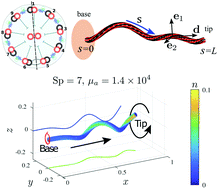Self-sustained three-dimensional beating of a model eukaryotic flagellum†
Abstract
Flagella and cilia are common features of a wide variety of biological cells and play important roles in locomotion and feeding at the microscale. The beating of flagella is controlled by molecular motors that exert forces along the length of the flagellum and are regulated by a feedback mechanism coupled to the flagella deformation. We develop a three-dimensional (3D) flagellum beating model based on sliding-controlled motor feedback, accounting for both bending and twist, as well as differential bending resistances along and orthogonal to the major bending plane of the flagellum. We show that beating is generated and sustained spontaneously for a sufficiently high motor activity through an instability mechanism. Isotropic bending rigidities in the flagellum lead to 3D helical beating patterns. By contrast, anisotropic flagella present a rich variety of wave-like beating dynamics, including both 3D beating patterns as well as planar beating patterns. We show that the ability to generate nearly planar beating despite the 3D beating machinery requires only a modest degree of bending anisotropy, and is a feature observed in many eukaryotic flagella such as mammalian spermatozoa.



 Please wait while we load your content...
Please wait while we load your content...